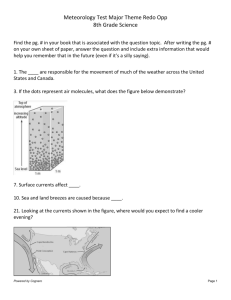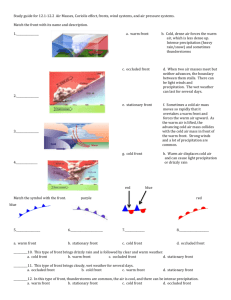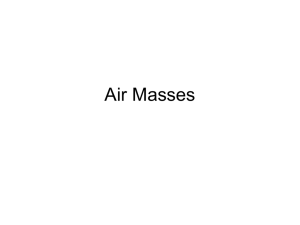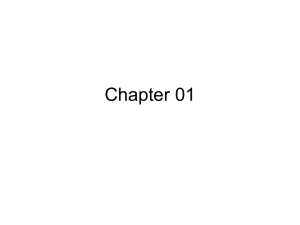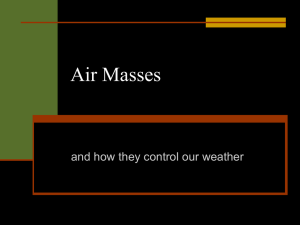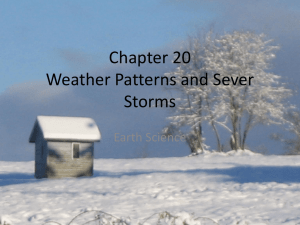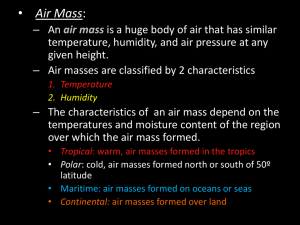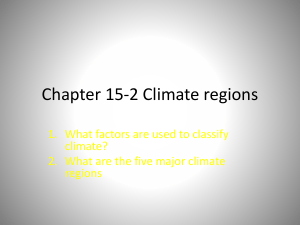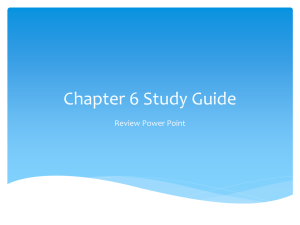Chapter_12
advertisement
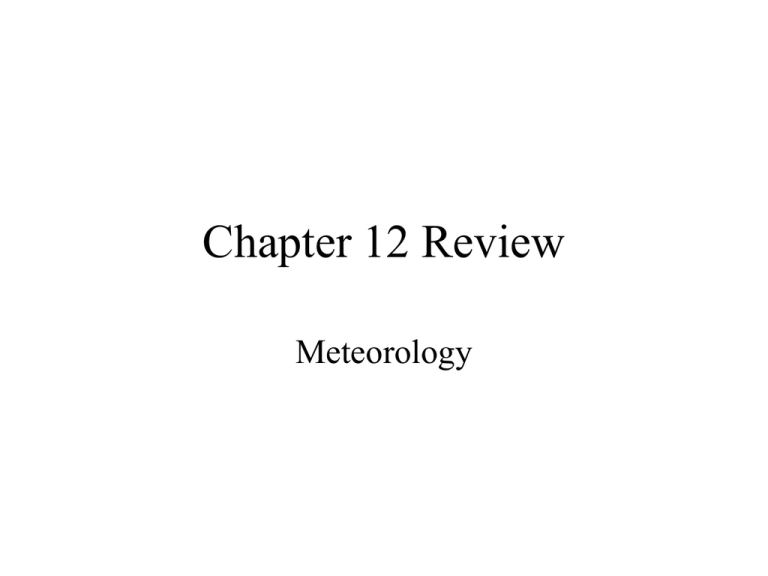
Chapter 12 Review Meteorology At what point do scientists classify an area’s weather as its climate? 1. 2. 3. 4. 1 year 5 years 15 years 30 years 0% 1 0% 0% 2 3 0% 4 The hot and humid weather in Texas during the summer is most likely due to what type of air mass? 1. 2. 3. 4. Continental polar Continental tropical Maritime polar Maritime tropical 0% 1 0% 0% 2 3 0% 4 Frigid air that travels southward from Canada would be what type of air mass? 1. 2. 3. 4. Continental polar Continental tropical Maritime polar Arctic 0% 1 0% 0% 2 3 0% 4 What type of front is being modeled in the diagram? 1. 2. 3. 4. cold front warm front stationary front occluded front 0% 1 0% 0% 2 3 0% 4 What type of weather is associated with this type of front? 1. widespread precipitation 2. light winds and precipitation 3. intense precipitation and thunderstorms 4. strong winds and heavy precipitation 0% 1 0% 0% 2 3 0% 4 What front is being forecast for this state? 1. 2. 3. 4. cold front warm front stationary front occluded front 0% 1 0% 0% 2 3 0% 4 What type of air was at point A and point B to produce this front? 1. 2. 3. 4. Cold air at point A and warm air at point B Warm air at point A and cold air at point B Cold air at point A and cold air at point B Warm air at point A and warm air at point B 0% 1 0% 0% 2 3 0% 4 Air Mass Type Source Region Winter Characteristics Continental polar interiors of Canada and Alaska very cold, dry Continental tropical southwest United States, Mexico warm, dry Maritime polar North Pacific Ocean mild, humid Maritime polar North Atlantic Ocean cold, humid 1. 2. 3. 4. Which air mass produces Seattle’s heavy winter precipitation? Continental polar Continental tropical Maritime polar, north Pacific ocean Maritime polar, north Atlantic ocean 0% 1 0% 0% 2 3 0% 4 Air Mass Type Source Region Winter Characteristics Continental polar interiors of Canada and Alaska very cold, dry Continental tropical southwest United States, Mexico warm, dry Maritime polar North Pacific Ocean mild, humid Maritime polar North Atlantic Ocean cold, humid 1. 2. 3. 4. central Canada Mexico northern California Maine Which region would be the warmest during the winter as a result of its air mass? 0% 1 0% 0% 2 3 0% 4 What direction is the wind moving? 1. 2. 3. 4. Northeast Southeast Northwest Southwest 0% 1 0% 0% 2 3 0% 4 What is the barometric pressure in mb? 1. 2. 3. 4. 1010 10264 1026.4 1010.8 0% 1 0% 2 0% 3. 0% 4. 1. 2. 3. 4. light clouds clear heavy clouds hazy What does the sky look like at the location with this station model? 0% 1 0% 0% 2 3 0% 4 Current, short-term variations in the atmosphere are referred to as ____. 1. 2. 3. 4. humidity lapse rate weather the ionosphere 0% 1 0% 0% 2 3 0% 4 The Coriolis effect is due to the ____ of Earth. 1. 2. 3. 4. revolution rotation shape density 0% 1 0% 0% 2 3 0% 4 Low-pressure systems are usually associated with ____ weather. 1. 2. 3. 4. cold and dry cloudy and rainy sunny and dry warm and humid 0% 1 0% 0% 2 3 0% 4 A(n) ____ forecast involves comparing current weather patterns to patterns that took place in the past. 1. 2. 3. 4. real-time digital analog comparative 0% 1 0% 0% 2 3 0% 4 Whether the day will be rainy or dry can be predicted somewhat accurately by a long-term forecast at the ____ range. 1. 2. 3. 4. one- to two-month four- to seven-day one- to three-day one- to two-week 0% 1 0% 0% 2 3 0% 4 A balloon-borne package of sensors that gathers upper-level temperature, air pressure, and humidity is ____. 1. 2. 3. 4. a radiosonde a satellite a hygrometer Doppler radar 0% 1 0% 0% 2 3 0% 4 The change in wave frequency of energy as it moves toward or away from an observer is the ____. 1. 2. 3. 4. Coriolis effect Doppler effect convergence effect radar effect 0% 1 0% 0% 2 3 0% 4 Differences in thermal energy can be detected with ____. 1. ultraviolet imagery 2. visible light 3. infrared imagery 4. sonar imagery 0% 1 0% 0% 2 3 0% 4 A record of weather data for a particular site at a particular time is a(n) ____. 1. 2. 3. 4. station model topographic map isopleth model climate map 0% 1 0% 0% 2 3 0% 4 Maritime polar (northern Pacific, Bering Sea) 1. 2. 3. 4. warm and humid cold and dry cool and humid warm and dry 0% 1 0% 0% 2 3 0% 4 Maritime tropical (Gulf of Mexico) 1. 2. 3. 4. warm and humid cold and dry cool and humid warm and dry 0% 1 0% 0% 2 3 0% 4 Continental tropical (southwestern desert of the United States) 1. 2. 3. 4. warm and humid cold and dry cool and humid warm and dry 0% 1 0% 0% 2 3 0% 4 Continental polar (central Canada) 1. 2. 3. 4. warm and humid cold and dry cool and humid warm and dry 0% 1 0% 0% 2 3 0% 4 Systems that lie between the poles and about 60° latitude in both hemispheres 1. trade winds 2. polar easterlies 3. prevailing westerlies 4. jet streams 0% 1 0% 0% 2 3 0% 4 Narrow bands of fast, highaltitude westerly winds 1. trade winds 2. polar easterlies 3. prevailing westerlies 4. jet streams 0% 1 0% 0% 2 3 0% 4 Winds occurring between 30° north and south latitude and the equator 1. trade winds 2. polar easterlies 3. prevailing westerlies 4. jet streams 0% 1 0% 0% 2 3 0% 4 Winds that flow between 30° and 60° north and south latitude 1. trade winds 2. polar easterlies 3. prevailing westerlies 4. jet streams 0% 1 0% 0% 2 3 0% 4 The diagram shows a low-pressure system in the northern hemisphere. 1. True 2. False 0% 1 0% 2 This system provides generally pleasant weather. 1. True 2. False 0% 1 0% 2 This system always rotates in a counterclockwise direction. 1. True 2. False 0% 1 0% 2 Due to the overtaking of a warm front by a cold front, an occluded front provides cold but clear weather. 1. True 2. False 0% 1 0% 2 Weather is mostly dependent on changes that occur high up in the troposphere 1. True 2. False 0% 1 0% 2 Imbalances in Earth’s heat energy help to create weather. 1. True 2. False 0% 1 0% 2 Due to the Coriolis effect, moving air particles are deflected to the right in the northern hemisphere and to the left in the southern hemisphere. 1. True 2. False 0% 1 0% 2 Weather radar allows meteorologists to track precipitation but not clouds, whereas weather satellites track clouds but not necessarily precipitation. 1. True 2. False 0% 1 0% 2 A(n) analog forecast relies on numerical data. 1. True 2. False 0% 1 0% 2
